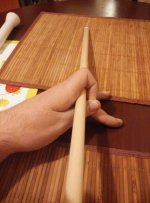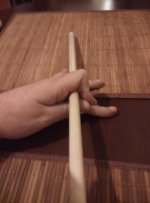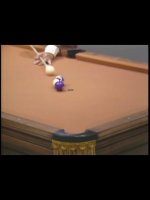I mostly play with a closed bridge. I think my closed bridge has some room for improvement, in terms of creating snugness.
I'm not engaged in wishful thinking that the issue rests entirely with shaft thickness, as I recognize that the exact positioning of my fingers isn't quite textbook, and creates some potential for movement (looseness, wiggle). But, having long played with one cue stick with one shaft, and then having picked up a second stick with a thinner shaft (I haven't measured the thickness of either one of them), and realizing that there just isn't as much looseness when I play with my original stick (the one with a thicker shaft), I have to believe that shaft thickness is actually a big deal -- at least if you play with a closed bridge. Hand sizes -- especially finger length and finger thickness -- vary a lot.
So, how could shaft thickness not be quite important? Yet, I don't read much of anything about proper fit -- its importance, and how to determine it. The same is in golf -- at least for those who haven't been shown the light. Most golfers buy a set of clubs with standard grips, not knowing their proper grip size. I did this for decades, only recently learning that I needed an oversized grip. It made a big difference. The same should hold true in pool. Is there a measuring/fitting system that will identify a "correct" shaft diameter for me? Going only on feel (most of us are going to like the feel of what we are used to holding, not the feel of what is actually properly sized for our hands) strikes me as a poor way to select shaft thickness. Thanks in advance for your thoughts.
I'm not engaged in wishful thinking that the issue rests entirely with shaft thickness, as I recognize that the exact positioning of my fingers isn't quite textbook, and creates some potential for movement (looseness, wiggle). But, having long played with one cue stick with one shaft, and then having picked up a second stick with a thinner shaft (I haven't measured the thickness of either one of them), and realizing that there just isn't as much looseness when I play with my original stick (the one with a thicker shaft), I have to believe that shaft thickness is actually a big deal -- at least if you play with a closed bridge. Hand sizes -- especially finger length and finger thickness -- vary a lot.
So, how could shaft thickness not be quite important? Yet, I don't read much of anything about proper fit -- its importance, and how to determine it. The same is in golf -- at least for those who haven't been shown the light. Most golfers buy a set of clubs with standard grips, not knowing their proper grip size. I did this for decades, only recently learning that I needed an oversized grip. It made a big difference. The same should hold true in pool. Is there a measuring/fitting system that will identify a "correct" shaft diameter for me? Going only on feel (most of us are going to like the feel of what we are used to holding, not the feel of what is actually properly sized for our hands) strikes me as a poor way to select shaft thickness. Thanks in advance for your thoughts.


